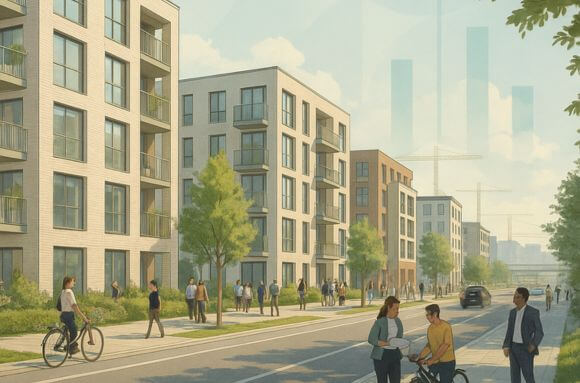The Croí Cónaithe (Cities) Scheme is a government initiative designed to make urban apartment development financially viable in Ireland’s major cities. Managed by The Housing Agency on behalf of the Department of Housing, Local Government and Heritage, the scheme supports developers in bridging the “viability gap”—the difference between what it costs to build apartments and what they can be sold for in the open market.
Launched as part of Ireland’s Housing for All strategy, the scheme is focused on stimulating new supply in central urban locations, helping deliver homes to owner-occupiers where demand is high and delivery has lagged due to economic pressures.
How the Croí Cónaithe Cities Scheme Works
In many urban areas, high construction costs and capped sale prices mean that even fully planned developments are financially unviable to deliver. The Croí Cónaithe scheme provides funding to cover this shortfall, ensuring that apartments can be built and sold to owner-occupiers without loss to the developer.
Here’s how it functions:
- Developers submit eligible apartment projects for funding consideration.
- A transparent open book viability assessment determines the funding required to make the project viable.
- Once approved, the developer receives targeted financial support to help deliver the homes, which must be sold directly to owner-occupiers—not investors or institutions.
This approach supports the government’s goal of promoting compact, sustainable urban growth, while simultaneously addressing the housing shortage in key cities.
Learn more via The Housing Agency.
Eligibility Criteria for Developers
To qualify for the scheme, developers must meet strict criteria that prioritise location, density, design quality, and readiness. Specifically, projects must:
- Be located within metropolitan areas of Dublin, Cork, Galway, Limerick, or Waterford
- Include apartment blocks that are 4+ storeys in height and have a net density of at least 35 dwellings per hectare
- Be within walking distance of high-quality public transport
- Offer homes for owner-occupier sale only
- Demonstrate a genuine viability gap and hold full planning permission (construction must not have started)
Developers are required to undergo a detailed financial review, ensuring funds are used precisely to offset the economic shortfall between cost and sale price—no more, no less.
Benefits for Buyers, Developers, and Communities
The Croí Cónaithe Cities Scheme represents a rare alignment of incentives that benefit multiple stakeholders:
For Homebuyers
- Increased availability of new apartments in city centres
- Focus on ownership, not investment, promoting long-term community stability
- Access to modern, energy-efficient housing with proximity to schools, jobs, and transit
For Developers
- A clear path to unlock sites that would otherwise remain idle
- Financial viability without compromising quality or design
- Enhanced alignment with ESG principles and government-backed frameworks
For Cities and Communities
- Supports compact urban growth, reducing sprawl and car dependency
- Helps revitalise underutilised plots and reduces dereliction
- Contributes to vibrant, sustainable neighbourhoods built for the future
See where Ireland stands now in the 2025 Irish Housing Supply Forecast: ESRI & CSO Data Digest.
Case Study: Woodbrook Point, Shankill
One such development that reflects the goals of the Croí Cónaithe Cities Scheme is Woodbrook, located beside Shankill Village in South County Dublin.
Set within the broader Woodbrook Masterplan, this 78-unit scheme includes:
- 1-bedroom and 2-bedroom apartments
- 2-bedroom duplex homes
- Integrated community amenities such as a Neighbourhood Centre, café/restaurant, pharmacy, creche, and a planned primary school
Connected, Sustainable Living
Woodbrook Point’s location is further enhanced by excellent transport infrastructure:
- A brand new Woodbrook DART Station (opening Summer 2025), offering direct access to Dublin City Centre
- Bus routes 45A, 45B, and E1 available nearby
- Immediate access to the M11 and M50 motorways via Wilford Junction
Completion Timeline
The development is on track for completion by late 2026 to early 2027, and is being planned with long-term community needs in mind—combining quality design, environmental standards, and accessibility.
As a development that aligns with the goals of the Croí Cónaithe Scheme, Woodbrook Point stands as a clear example of how Castlethorn is delivering practical, people-first housing in Ireland’s most connected locations.
Interested in making this property your next home or owned property? Register your interest today!
Final Thoughts
The Croí Cónaithe (Cities) Scheme is not just a policy initiative—it’s a pragmatic response to real challenges facing Irish urban housing. By addressing the viability gap, it enables developers to build homes that might otherwise never reach the market. For homebuyers, it means more opportunity to live in vibrant, well-connected communities.
At Castlethorn, we are proud to support this mission—combining decades of development experience with a commitment to sustainable, community-led design. As the scheme progresses, we will continue to explore opportunities where we can deliver value to future residents and urban neighbourhoods alike.
Interested in learning more about Castlethorn’s eligible developments?
Contact us to explore opportunities under the Croí Cónaithe (Cities) Scheme.




